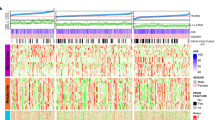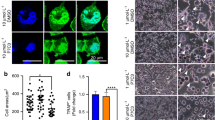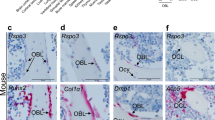Abstract
The purinergic P2X7 receptor has a major role in the regulation of osteoblast and osteoclast activity and changes in receptor function may therefore affect bone mass in vivo. The aim of this study was to determine the association of non-synonymous single-nucleotide polymorphisms in the P2RX7 gene to bone mass and fracture incidence in post-menopausal women. A total of 1694 women (aged 45–58) participating in the Danish Osteoporosis Prevention Study were genotyped for 12 functional P2X7 receptor variants. Bone mineral density was determined at baseline and after 10 years. In addition, vertebral fracture incidence was documented at 10 years. We found that the rate of bone loss was clearly associated with the Arg307Gln amino acid substitution such that individuals heterozygous for this polymorphism had a 40% increased rate of bone loss. Furthermore, individuals carrying the Ile568Asn variant allele had increased bone loss. In contrast, the Gln460Arg polymorphism was associated with protection against bone loss. The Ala348Thr polymorphism was associated with a lower vertebral fracture incidence 10 years after menopause. Finally, we developed a risk model, which integrated P2RX7 genotypes. Using this model, we found a clear association between the low-risk (high-P2X7 function) alleles and low rate of bone loss. Conversely, high-risk (reduced P2X7 function) alleles were associated with a high rate of bone loss. In conclusion, an association was demonstrated between variants that reduce P2X7 receptor function and increased rate of bone loss. These data support that the P2X7 receptor is important in regulation of bone mass.
Similar content being viewed by others
Log in or create a free account to read this content
Gain free access to this article, as well as selected content from this journal and more on nature.com
or
References
Johnell O, Kanis J : Epidemiology of osteoporotic fractures. Osteoporos Int 2005; 16 (Suppl 2): S3–S7.
Ralston SH : Genetic determinants of susceptibility to osteoporosis. Curr Opin Pharmacol 2003; 3: 286–290.
Richards JB, Kavvoura FK, Rivadeneira F et al: Genetic factors for Osteoporosis Consortium. Collaborative meta-analysis: associations of 150 candidate genes with osteoporosis and osteoporotic fracture. Ann Intern Med 2009; 151: 528–537.
Khakh BS, North RA : P2X receptors as cell-surface ATP sensors in health and disease. Nature 2006; 442: 527–532.
Surprenant A, Rassendren F, Kawashima E, North RA, Buell G : The Cytolytic P2Z receptor for extracellular ATP identified as a P2X receptor (P2X7). Science 1996; 272: 735–738.
Steinberg TH, Silverstein SC : Extracellular ATP4- promotes cation fluxes in the J774 mouse macrophage cell line. J Biol Chem 1987; 262: 3118–3122.
Steinberg TH, Newman AS, Swanson JA, Silverstein SC : ATP4- permeabilizes the plasma membrane of mouse macrophages to fluorescent dyes. J Biol Chem 1987; 262: 8884–8888.
Collo G, Neidhart S, Kawashima E, Kosco-Vilbois M, North RA, Buell G : Tissue distribution of the P2X7 receptor. Neuropharmacology 1997; 36: 1277–1283.
Rassendren F, Buell GN, Virginio C, Collo G, North RA, Surprenant A : The permeabilizing ATP receptor, P2X7. Cloning and expression of a human cDNA. J Biol Chem 1997; 272: 5482–5486.
Ferrari D, Chiozzi P, Falzoni S, Hanau S, Di Virgilio F : Purinergic modulation of interleukin-1 beta release from microglial cells stimulated with bacterial endotoxin. J Exp Med 1997; 185: 579–582.
Jorgensen NR, Henriksen Z, Sorensen OH, Eriksen EF, Civitelli R, Steinberg TH : Intercellular calcium signaling occurs between human osteoblasts and osteoclasts and requires activation of osteoclast P2X7 receptors. J Biol Chem 2002; 277: 7574–7580.
Gartland A, Hipskind RA, Gallagher JA, Bowler WB : Expression of a P2X7 receptor by a subpopulation of human osteoblasts. J Bone Miner Res 2001; 16: 846–856.
Jorgensen NR : Short-range intercellular calcium signaling in bone. APMIS Suppl 2005; 118: 5–36.
Genetos DC, Kephart CJ, Zhang Y, Yellowley CE, Donahue HJ : Oscillating fluid flow activation of gap junction hemichannels induces ATP release from MLO-Y4 osteocytes. J Cell Physiol 2007; 212: 207–214.
Panupinthu N, Zhao L, Possmayer F, Ke HZ, Sims SM, Dixon SJ : P2X7 nucleotide receptors mediate blebbing in osteoblasts through a pathway involving lysophosphatidic acid. J Biol Chem 2007; 282: 3403–3412.
Gu B, Bendall LJ, Wiley JS : Adenosine triphosphate-induced shedding of CD23 and L-selectin (CD62 L) from lymphocytes is mediated by the same receptor but different metalloproteases. Blood 1998; 92: 946–951.
Ohlendorff SD, Tofteng CL, Jensen JE et al: Single nucleotide polymorphisms in the P2X7 gene are associated to fracture risk and to effect of estrogen treatment. Pharmacogenet Genomics 2007; 17: 555–567.
Qu Y, Franchi L, Nunez G, Dubyak GR : Nonclassical IL-1 beta secretion stimulated by P2X7 receptors is dependent on inflammasome activation and correlated with exosome release in murine macrophages. J Immunol 2007; 179: 1913–1925.
Ferrari D, Pizzirani C, Adinolfi E et al: The P2X7 receptor: a key player in IL-1 processing and release. J Immunol 2006; 176: 3877–3883.
Solle M, Labasi J, Perregaux DG et al: Altered cytokine production in mice lacking P2X(7) receptors. J Biol Chem 2001; 276: 125–132.
Kim JH, Jin HM, Kim K et al: The mechanism of osteoclast differentiation induced by IL-1. J Immunol 2009; 183: 1862–1870.
Gartland A, Buckley KA, Bowler WB, Gallagher JA : Blockade of the pore-forming P2X7 receptor inhibits formation of multinucleated human osteoclasts in vitro. Calcif Tissue Int 2003; 73: 361–369.
Korcok J, Raimundo LN, Ke HZ, Sims SM, Dixon SJ : Extracellular nucleotides act through P2X7 receptors to activate NF-kappaB in osteoclasts. J Bone Miner Res 2004; 19: 642–651.
Ke HZ, Qi H, Weidema AF et al: Deletion of the P2X7 nucleotide receptor reveals its regulatory roles in bone formation and resorption. Mol Endocrinol 2003; 17: 1356–1367.
Orriss I, Syberg S, Wang N et al: Bone phenotypes of P2 receptor knockout mice. Frontiers Biosci 2011; 17: 2572–2585.
Li J, Liu D, Ke HZ, Duncan RL, Turner CH : The P2X7 nucleotide receptor mediates skeletal mechanotransduction. J Biol Chem 2005; 280: 42952–42959.
Wesselius A, Bours M, Agrawal A et al: Role of purinergic receptor polymorphisms in human bone. Frontiers Biosci 2011; 16: 2572–2585.
Fuller SJ, Stokes L, Skarratt KK, Gu BJ, Wiley JS : Genetics of the P2X7 receptor and human disease. Purinergic Signal 2009; 5: 257–262.
Gu BJ, Sluyter R, Skarratt KK et al: An Arg307 to Gln polymorphism within the ATP-binding site causes loss of function of the human P2X7 receptor. J Biol Chem 2004; 279: 31287–31295.
Stokes L, Fuller SJ, Sluyter R, Skarratt KK, Gu BJ, Wiley JS : Two haplotypes of the P2X7 receptor containing the Ala-348 to Thr polymorphism exhibit a gain-of-function effect and enhanced interleukin-1{beta} secretion. FASEB J 2010; 24: 2916–2927.
Mosekilde L, Hermann AP, Beck-Nielsen H, Charles P, Nielsen SP, Sorensen OH : The Danish Osteoporosis Prevention Study (DOPS): project design and inclusion of 2000 normal perimenopausal women. Maturitas 1999; 31: 207–219.
Fernando SL, Saunders BM, Sluyter R et al: A polymorphism in the P2X7 gene increases susceptibility to extrapulmonary tuberculosis. Am J Respir Crit Care Med 2007; 175: 360–366.
Shemon AN, Sluyter R, Fernando SL et al: A Thr357 to Ser polymorphism in homozygous and compound heterozygous subjects causes absent or reduced P2X7 function and impairs ATP-induced mycobacterial killing by macrophages. J Biol Chem 2006; 281: 2079–2086.
Stevens M, Smith N, Donnelly P : A new statistical method for haplotype reconstruction from population data. Am J Hum Genet 2001; 68: 978–989.
Gartland A, Skarratt KK, Hocking LJ et al: Polymorphisms in the P2X7 receptor gene are associated with low lumbar spine BMD and accelerated bone loss in younger post-menopausal women. Eur J Human Genet 2011; e-pub ahead of print 11 January 2012, doi:10.1038/ejhg.2011.245
Mrazek F, Gallo J, Stahelova A, Petrek M : Functional variants of the P2X7R gene, aseptic osteolysis, and revision of the total hip arthroplasty: a preliminary study. Human Immunol 2010; 71: 201–205.
Wiley JS, Dao-Ung LP, Li C et al: An Ile-568 to Asn polymorphism prevents normal trafficking and function of the human P2X7 receptor. J Biol Chem 2003; 278: 17108–17113.
Guo C, Masin M, Qureshi OS, Murrell-Lagnado RD : Evidence for functional P2X4/P2X7 heteromeric receptors. Mol Pharmacol 2007; 72: 1447–1456.
Uhthoff HK, Jaworski ZF : Bone loss in response to long-term immobilisation. J Bone Joint Surg Br 1978; 60-B: 420–429.
Panupinthu N, Rogers JT, Zhao L et al: P2X7 receptors on osteoblasts couple to production of lysophosphatidic acid: a signaling axis promoting osteogenesis. J Cell Biol 2008; 181: 859–871.
Naemsch LN, Dixon SJ, Sims SM : Activity-dependent development of P2X7 current and ca2+ entry in rabbit osteoclasts. J Biol Chem 2001; 276: 39107–39114.
Skarratt KK, Fuller SJ, Sluyter R, Dao-Ung LP, Gu BJ, Wiley JS : A 5′ intronic splice site polymorphism leads to a null allele of the P2X7 gene in 1–2% of the Caucasian population. FEBS Lett 2005; 579: 2675–2678.
Fernando SL, Saunders BM, Sluyter R, Skarratt KK, Wiley JS, Britton WJ : Gene dosage determines the negative effects of polymorphic alleles of the P2X7 receptor on adenosine triphosphate-mediated killing of mycobacteria by human macrophages. J Infect Dis 2005; 192: 149–155.
Roger S, Mei ZZ, Baldwin JM et al: Single nucleotide polymorphisms that were identified in affective mood disorders affect ATP-activated P2X7 receptor functions. J Psychi Res 2010; 44: 347–355.
Cabrini G, Falzoni S, Forchap SL et al: A His-155 to Tyr polymorphism confers gain-of-function to the human P2X7 receptor of human leukemic lymphocytes. J Immunol 2005; 175: 82–89.
Sun C, Chu J, Singh S, Salter RD : Identification and characterization of a novel variant of the human P2X7 receptor resulting in gain of function. Purinergic Signal 2010; 6: 31–45.
Gu BJ, Zhang W, Worthington RA et al: A glu-496 to ala polymorphism leads to loss of function of the human P2X7 receptor. J Biol Chem 2001; 276: 11135–11142.
Wiley JS, Dao-Ung LP, Gu BJ et al: A loss-of-function polymorphic mutation in the cytolytic P2X7 receptor gene and chronic lymphocytic leukaemia: a molecular study. Lancet 2002; 359: 1114–1119.
Sluyter R, Shemon AN, Wiley JS : Glu496 to Ala polymorphism in the P2X7 receptor impairs ATP-induced IL-1 beta release from human monocytes. J Immunol 2004; 172: 3399–3405.
Saunders BM, Fernando SL, Sluyter R, Britton WJ, Wiley JS : A loss-of-function polymorphism in the human P2X7 receptor abolishes ATP-mediated killing of mycobacteria. J Immunol 2003; 171: 5442–5446.
Sluyter R, Dalitz JG, Wiley JS : P2X7 receptor polymorphism impairs extracellular adenosine 5′-triphosphate-induced interleukin-18 release from human monocytes. Genes Immun 2004; 5: 588–591.
Acknowledgements
The work was kindly supported by the European Commission under the 7th Framework Programme (proposal #202231) performed as a collaborative project among the members of the ATPBone Consortium (Copenhagen University, University College London, University of Maastricht, University of Ferrara, University of Liverpool, University of Sheffield and Université Libre de Bruxelles), and is a substudy under the main study ‘Fighting osteoporosis by blocking nucleotides: purinergic signalling in bone formation and homeostasis’. Furthermore, this work was funded by the Research Foundation on Hvidovre Hospital H:S, Denmark in 2003 and 2006. We thank the National Health and Medical Research Council of Australia for support.
Author information
Authors and Affiliations
Corresponding author
Ethics declarations
Competing interests
The authors declare no conflict of interest.
Additional information
Supplementary Information accompanies the paper on European Journal of Human Genetics website
Supplementary information
Rights and permissions
About this article
Cite this article
Jørgensen, N., Husted, L., Skarratt, K. et al. Single-nucleotide polymorphisms in the P2X7 receptor gene are associated with post-menopausal bone loss and vertebral fractures. Eur J Hum Genet 20, 675–681 (2012). https://doi.org/10.1038/ejhg.2011.253
Received:
Revised:
Accepted:
Published:
Issue date:
DOI: https://doi.org/10.1038/ejhg.2011.253
Keywords
This article is cited by
-
Silencing NTPDase3 activity rehabilitates the osteogenic commitment of post-menopausal stem cell bone progenitors
Stem Cell Research & Therapy (2023)
-
Adult mesenchymal stem cells: is there a role for purine receptors in their osteogenic differentiation?
Purinergic Signalling (2020)
-
Bone's Response to Mechanical Loading in Aging and Osteoporosis: Molecular Mechanisms
Calcified Tissue International (2020)
-
Association between the rs3751143 polymorphism of P2RX7 gene and chronic lymphocytic leukemia: A meta-analysis
Purinergic Signalling (2020)
-
Altered donor P2X7 activity in human leukocytes correlates with P2RX7 genotype but does not affect the development of graft-versus-host disease in humanised mice
Purinergic Signalling (2019)



